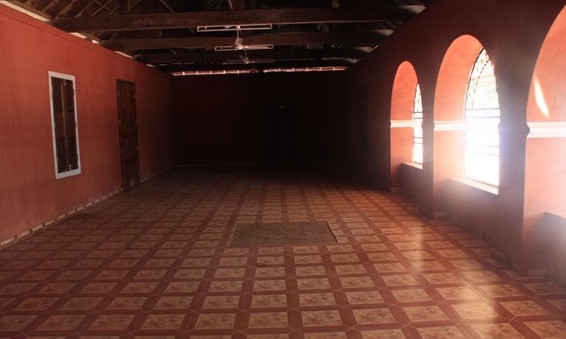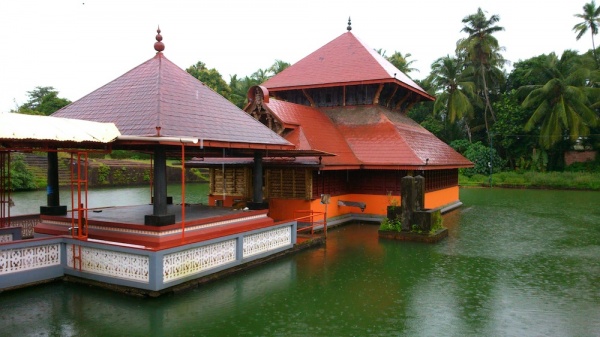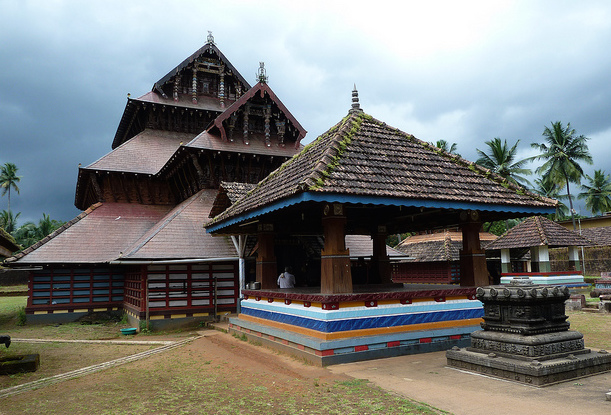Perne Muchilot Kavu and its History
Perne, the dwelling place of Goddess Bhagavathi, is affiliated with rich tradition and has vivid aestheticism dating back over 260 years. Approved of the tradition, culture, and hospitality, the Vaniya Community decided to settle in Tulunadu on the Western Ghats and hence were called GANIGA’s. As Tulunadu is significantly far from their native places, Ganigas came to an agreement and decided to establish a Muchilot Kavu, and thus the place Perne was founded.
Perne was part of Kumbla Seema, which was administered by the Maipady king. Vaniyas approached the Maipady rulers and sought their consent to build a “Kavu”. Their wish was granted, and the Maipady kings maintained a pleasant relationship with the Vaniya community. Maipady kings did not interfere in the administration of Perne. As part of the tradition, Ganigas chose Komaram for Muchilot Bhagavathi and other deities. He is entitled to this official status of Komara only after the Maipady king accredits him and bestows him with a golden bracelet. The golden bracelet symbolizes that he is the Darshana Padri of Daiva.

Whenever an event or festival is celebrated in Perne, the family of the Maipady dynasty is informed and invited. Kaliyatam is recognized with Devas visiting the palace to interact with the royal family. Vaniyas even seek the blessings of traditional holy places of Kumbla Seema such as Madhur Ganapathi, Adoor Mahalingeshwara, Kavu Parthasarathi, Kanipura GopalaKrishna, Ananthapura Padbhanabha. Darshana Padris narrate the stories of these gods during festivals at Perne to symbolize that relationship.
Vaniyas from five Seemas contributed monetarily according to their ability to the construction of the temple. The place was owned by Ananthapura Stanika Brahmins, and they bestowed their land for this holy purpose. Vaniyas of Kutyala Majal and Olal Taravadu committed and exerted their effort in building the Kavu, Well, and the Bhandara house. All the religious conventions are carried out by the Komaras, and the Komara of Bhagavathi Devi is the most significant person. All the activities of the Kshetram are spearheaded by him. The pooja-related activities are organized and undertaken by the four chosen Adiyantararus (Naltyararus), all four have equal eminence. The nine Karnavamars have charge of social activities; the first four enjoy more prominence. These people function with the assistance of Chettiyanmars, Raddek Acchanmars, and Pattikarmars who collect house rent (“Mane Denige”). All these efforts for years now have contributed to the smooth running of the Kshetram, making it the divine and auspicious place it is now.
Uliya Tantri carried out all the religious activities of Kshetram until a hundred years ago. Under him, Bal Bhandharah was placed in the Uliya Palace and was brought to the Kshetram during festivals. Icchilapadi Bhant family expressed their liking and authority in the activities of Perne. All the social and religious leaders were involved and invited to the religious activities of the Kshetra.

In 1980, a difference of opinion led to the division of Vaniyas into two. In 1986, a clash over Kaliyatam ended in the interference of the sub-magistrate of Puttur and the police to conduct Kaliyatam. After that, Icchilpadi Kotyanna Bhanta and his loyal Vaniyas filed a case in Puttur Magistrate court and Kasargod Magistrate court claiming the rights to Perne. The group that opposed this handover of rights sought the help of the Patela of the village, Ananthapura Ishwarayya (Stanika Brahmin). With his help, they won the case, and it was awarded to be the Adalitha Muktheshwara of the Kshetram and became the mentor of the Vaniya community.
Even now, Stanika Brahmins are regarded with utmost respect and love by the community. The Ananthapura family has shown a lot of eagerness for the progress of the community. One of the Muktheshwara, Sri Shanakra Narayanayya, has donated paddy land for the temple. In the turn of events, Uliya Tantri backed off from all the activities of Perne. Later, Bal Bhandara was kept at Ananthapura, and now Kalasa Sthana is being carried out in the Ananthapura temple. Every year during the festival, Acchanmars and Nalthyars visit the Ananthapura temple, perform Kalasa Sthana, and they return with Bal Bhandara. At the end of the festival, the bhandara is taken back along with the banana cluster.
Muktheshwara is regarded with great respect. He is offered a separate seat in Sathya Chavadi, and his responsibility is to solve all the issues related to the Kshetram. During Kaliyatam, Daiva converses with him first, and he gets to have Prasadam before everyone else. It's a relationship of trust and love completely enthralled with devotion to the Devi that carries all the people forward.
The Vaniya community mainly were oil vendors and were settled in various parts of Kerala/South Karnataka. The culture and language of the community varied depending on the location. Once the group of Vaniyans from North Kerala attended Kaliyata Mahotsavam in Karipodi. People of Karipodi, who were jealous of the culture and lifestyle of North Kerala, planned to insult them. They mixed the itching leaves of a plant (Nayi Sonaga) into water used for washing hands. Innocent Vaniyas of North, who washed their hands and bathed in that water, faced itching, burning of the skin, swelling, and watery blistering.
Devotees from North Kerala realized the trick played by people of Karipodi. They gathered together and prayed to Devi and explained the insult. They also made the promise that they would never visit Karipodi again and left Karipodi the same night. Devi heard their prayers and blessed them. She came along with them. They reached a place called Chandragiri. They had to cross the river, but there was no boat available since it was dawn. They were worried and started praying again. Devi entered the body of “Chorla Vaniya” and he divided the river into two using a knife. Once everyone crossed, the river joined again.
Due to all these events, Vaniyas got a strong feeling that Devi has come along with them. After entering the north, Bhagavathi Devi went to Bedradka Poomani Kinnimani temple where the festival was going on. A Chorla Vaniya of Majal ancestry used to light lamps in that temple. During Beernalva Daiva Utsthava, Bhagavathi enters the body of Chorla Vaniya and asks for permission to settle. Beernnalva directs Devi to ask permission from Mahalingshwera Deva of Kumbla seeme. Beernalva shows the path to the Mahalingeshwara temple and asks for a shrine to him in a place where Bhagavathi Devi settles. Since Devi darshana happened on Chorla vaniyan of Majal ancestry, Komara of Perne Muchilot Bhagavathi Devi belongs to Chorla. During Kaliyata mahostavam, the things used for the initial Ganapathi pooja (rice, coconut, banana, etc.) are preserved and taken to the Majal house after Kaliyatam. Dinner is arranged there for people of the community.

Bhagavathi enters Adoor Mahalingashivara temple where a festival was going on and asks for a place in Kumbala seema. The person who was (Adigalu) carrying Bali of god rejects the request and denies the place. Saddened by it, Devi curses the Adigalu that he would not be able to keep the god down and sits at a place called Iruvanji near the temple. At the end of the function, Adigalu, on trying to keep Bali down, fails. Adigalu realizes his mistakes and grants permission to her to settle. He advises to take permission from Madhur Ganapathi, Kanipura Gopalakrisha, and Mujungavu Parthasarathi. She searches for a place to settle and finds a place where cow, tiger, snake, and mongoose lived happily. It was a place where the “Ashwatha” plant and “Blinder” plant were found. This place was “Peru tana”. In Peru tana, inside satya chavadi (padipura), a sage was praying.
Thus, the Last Kavu was built for Muchilot Bhagavathi. Ananthapura ancestry donated this place for Vaniyas. Perne became a single place of worship for North Vaniyas.